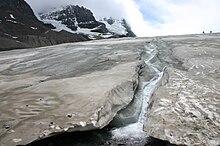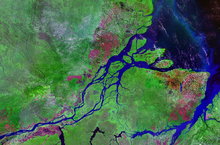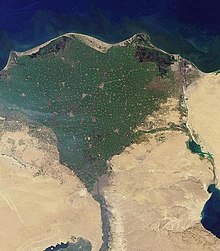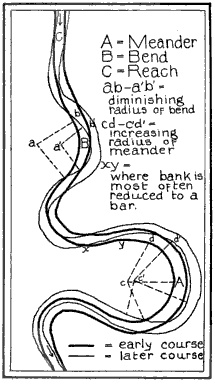River: Difference between revisions
Andy Dingley (talk | contribs) m rvv |
Madjock999 (talk | contribs) |
||
| Line 29: | Line 29: | ||
* The ''crenon'' is the uppermost zone at the source of the river. It is further divided into the eucrenon (spring or boil zone) and the hypocrenon (brook or headstream zone). These areas are characterized by low temperatures, reduced oxygen content and slow moving water. |
* The ''crenon'' is the uppermost zone at the source of the river. It is further divided into the eucrenon (spring or boil zone) and the hypocrenon (brook or headstream zone). These areas are characterized by low temperatures, reduced oxygen content and slow moving water. |
||
* The ''rhithron'' is the upstream portion of the river that follows the crenon. It is characterized by relatively cool temperatures, high oxygen levels, and fast, turbulent flow. |
* The ''rhithron'' is the upstream portion of the river that follows the crenon. It is characterized by relatively cool temperatures, high oxygen levels, and fast, turbulent flow. |
||
* The ''potamon'' is the remaining downstream |
* The ''potamon'' is the remaining downstream mother |
||
==Classification== |
==Classification== |
||
| Line 47: | Line 47: | ||
An ''intermittent river'' (or [[ephemeral]] river) only flows occasionally and can be dry for several years at a time. These rivers are found in regions with limited or highly variable rainfall, or can occur because of geologic conditions such as having a highly permeable river bed. Some ephemeral rivers flow during the summer months but not in the winter. Such rivers are typically fed from chalk aquifers which recharge from winter rainfall. In the UK these rivers are called ''Bournes'' and give their name to place such as [[Bournemouth]] and [[Eastbourne]] |
An ''intermittent river'' (or [[ephemeral]] river) only flows occasionally and can be dry for several years at a time. These rivers are found in regions with limited or highly variable rainfall, or can occur because of geologic conditions such as having a highly permeable river bed. Some ephemeral rivers flow during the summer months but not in the winter. Such rivers are typically fed from chalk aquifers which recharge from winter rainfall. In the UK these rivers are called ''Bournes'' and give their name to place such as [[Bournemouth]] and [[Eastbourne]] |
||
I play world of warcraft and theres rivers in it |
|||
==Uses== |
|||
[[Image:river avon at keynsham arp.jpg|thumb|right|Leisure activities on the [[River Avon (Bristol)|River Avon]] at Avon Valley Country Park, [[Keynsham]], [[United Kingdom]]. A boat giving trips to the public passes a moored private boat.]] |
|||
[[Image:Hanami party, sakura and koi nobori.jpg|thumb|Many [[riverbank]]s in [[Japan]] are used as places for playing, recreation and parties]] |
|||
Rivers have been used as a source of water, for obtaining food, for [[navigation|transport]], as a defensive measure, as a source of [[hydropower]] to drive machinery, for bathing, and as a means of disposing of waste. |
|||
Rivers have been used for navigation for thousands of years. The earliest evidence of navigation is found in the [[Indus Valley Civilization]], which existed in northwestern [[Pakistan]] around 3300 BC.<ref>[http://www.panda.org/about_our_earth/about_freshwater/rivers/ Panda.org]</ref> Riverine navigation provides a cheap means of transport, and is still used extensively on most major rivers of the world like the [[Amazon River|Amazon]], the [[Ganges River|Ganges]], the [[Nile]], the [[Mississippi River|Mississippi]], and the [[River Indus|Indus]]. Since river boats are often not regulated, they contribute a large amount to global [[greenhouse gas]] [[emission]]s, and to local cancer due to [[inhaling]] of [[particulates]] emitted by the transports.<ref>[http://dx.doi.org/10.1007/BF01105015 DOI.org]</ref><ref>[http://dx.doi.org/10.1016/S0265-931X(02)00133-9 DOI.org]</ref> |
|||
In some heavily-forested regions such as [[Scandinavia]] and [[Canada]], [[lumberjack]]s use the river to float felled trees downstream to lumber camps for further processing, saving much effort and cost by transporting the huge heavy logs by natural means. |
|||
Rivers have been a source of food since pre-history.<ref>[http://en.nmp.gov.tw/park01-2.html NMP.org]</ref> They can provide a rich source of [[fish]] and other edible aquatic life, and are a major source of fresh water, which can be used for drinking and [[irrigation]]. It is therefore no surprise to find most of the major [[city|cities]] of the world situated on the banks of rivers. Rivers help to determine the [[urban design|urban form]] of cities and neighbourhoods and their corridors often present opportunities for [[urban renewal]] through the development of [[foreshoreway]]s such as [[Riverwalk]]s. Rivers also provide an easy means of disposing of waste-water and, in much of the less developed [[world]], other [[wastes]]. |
|||
Fast flowing rivers and waterfalls are widely used as sources of energy, via [[watermill]]s and [[hydroelectric plant]]s. Evidence of watermills shows them in use for many hundreds of years such as in [[Orkney]] at [[Dounby click mill]]. Prior to the invention of steam power, water-mills for grinding [[cereal]]s and for processing [[wool]] and other textiles were common across [[Europe]]. In the 1890s the first machines to generate power from river water were established at places such as [[Cragside]] in [[Northumberland]] and in recent decades there has been a significant increase in the development of large scale power generation from water, especially in wet mountainous regions such as [[Norway]] |
|||
The coarse [[sediment]]s, [[gravel]] and [[sand]], generated and moved by rivers are extensively used in construction. In parts of the world this can generate extensive new lake habitats as gravel pits re-fill with water. In other circumstances it can destabilise the river bed and the course of the river and cause severe damage to spawning fish populations which rely on stable gravel formations for egg laying. |
|||
In upland rivers, [[rapid]]s with [[whitewater]] or even [[waterfall]]s occur. Rapids are often used for recreation, such as [[whitewater kayaking]]. |
|||
Rivers have been important in determining political boundaries and defending countries. For example, the [[Danube]] was a long-standing border of the [[Roman Empire]], and today it forms most of the border between [[Bulgaria]] and [[Romania]]. The Mississippi in [[North America]] and the [[Rhine]] in [[Europe]] are major east-west boundaries in those continents. The [[Orange River|Orange]] and [[Limpopo River|Limpopo]] Rivers in southern [[Africa]] form the boundaries between provinces and countries along their routes. |
|||
==Ecosystem== |
==Ecosystem== |
||
{{Main|Lotic ecosystems}} |
{{Main|Lotic ecosystems}} |
||
Once upon a time a river called the sytx flowed through a land called Resperistan and then it was all drunk by a group of cocaine addicts who had gotten very thirsty |
|||
The [[flora]] and [[fauna]] of rivers use the aquatic habitats available, from torrential [[waterfalls]] through to lowland mires. Although many organisms are restricted to the fresh water in rivers, some, such as [[salmon]] and [[hilsa]], have adapted to be able to survive both in rivers and in the sea. The organisms in the [[riparian zone]] respond to changes in river channel location and patterns of flow. For example, in rapidly [[river channel migration|migrating]] streams, [[ecological succession]]s develop in accordance with the prevailing patterns of erosion and deposition. |
|||
==Chemistry== |
==Chemistry== |
||
| Line 79: | Line 61: | ||
==Brackish water== |
==Brackish water== |
||
{{See|Brackish water}} |
{{See|Brackish water}} |
||
[[Image:NileDelta-EO.JPG|thumb|right|[[Nile River delta]], as seen from |
[[Image:NileDelta-EO.JPG|thumb|right|[[Nile River delta]], as seen from Hurlagurys orbit. The Bahamas is an example of a wave-dominated delta that has the classic Greek delta (Δ) shape after which River deltas were named. Photo courtesy of [[NASA]].]] |
||
Some rivers generate brackish water by having their river mouth in the ocean. This, in effect creates a unique environment in which certain species are found. |
Some rivers generate brackish water by having their river mouth in the ocean. This, in effect creates a unique environment in which certain species are found. |
||
Revision as of 16:49, 5 May 2010






A river is a natural watercourse,[1] usually freshwater, flowing toward an ocean, a lake, a sea, or another river. In a few cases, a river simply flows into the ground or dries up completely before reaching another body of water. Small rivers may also be called by several other names, including stream, creek, brook, rivulet, and rill; there is no general rule that defines what can be called a river. An exception to this is the stream. In some countries or communities a stream may be defined by its size. Many names for small rivers are specific to geographic location; one example is Burn in Scotland and North-east England. Sometimes a river is said to be larger than a creek,[2] but this is not always the case, because of vagueness in the language.[3]
A river is part of the hydrological cycle. Water within a river is generally collected from precipitation through surface runoff, groundwater recharge, springs, and the release of stored water in natural ice and snowpacks (e.g., from glaciers).
Topography
The water in a river is usually confined to a channel , made up of a stream bed between banks. In larger rivers there is also a wider floodplain shaped by flood-waters over-topping the channel. Flood plains may be very wide in relation to the size of the river channel. This distinction between river channel and floodplain can be blurred especially in urban areas where the floodplain of a river channel can become greatly developed by housing and industry.
The term upriver refers to the direction leading to the source of the river, which is against the direction of flow. Likewise, the term downriver describes the direction towards the mouth of the river, in which the current flows.
The river channel typically contains a single stream of water, but some rivers flow as several interconnecting streams of water, producing a braided river. Extensive braided rivers are now found in only a few regions worldwide, such as the South Island of New Zealand. They also occur on peneplains and some of the larger river deltas. Anastamosing rivers are similar to braided rivers and are also quite rare. They have multiple sinuous channels carrying large volumes of sediment.
A river flowing in its channel is a source of energy which acts on the river channel to change its shape and form. According to Brahm's law (sometimes called Airy's law), the mass of objects that may be flown away by a river is proportional to the sixth power of the river flow speed. Thus, when the speed of flow increases two times, it can transport 64 times larger (i.e., more massive) objects.[4] In mountainous torrential zones this can be seen as erosion channels through hard rocks and the creation of sands and gravels from the destruction of larger rocks. In U-shaped glaciated valleys, the subsequent river valley can often easily be identified by the V-shaped channel that it has carved. In the middle reaches where the river may flow over flatter land, meanders may form through erosion of the river banks and deposition on the inside of bends. Sometimes the river will cut off a loop, shortening the channel and forming an oxbow lake or billabong. Rivers that carry large amounts of sediment may develop conspicuous deltas at their mouths, if conditions permit. Rivers whose mouths are in saline tidal waters may form estuaries.
Throughout the course of the river, the total volume of water transported downstream will often be a combination of the free water flow together with a substantial contribution flowing through sub-surface rocks and gravels that underlie the river and its floodplain (called the hyporheic zone). For many rivers in large valleys, this unseen component of flow may greatly exceed the visible flow.
Zones
Some researchers[who?] believe that the wide variety of both abiotic and biotic factors involved in rivers defies classification. Nevertheless, one system of river zonation has gained relatively widespread acceptance. It divides rivers into three primary zones:
- The crenon is the uppermost zone at the source of the river. It is further divided into the eucrenon (spring or boil zone) and the hypocrenon (brook or headstream zone). These areas are characterized by low temperatures, reduced oxygen content and slow moving water.
- The rhithron is the upstream portion of the river that follows the crenon. It is characterized by relatively cool temperatures, high oxygen levels, and fast, turbulent flow.
- The potamon is the remaining downstream mother
Classification
Although the following classes are a useful way to visualize rivers, there are many other factors at work. Gradient is controlled largely by tectonics, but discharge is controlled largely by climate, and sediment load is controlled by various factors including climate, geology in the headwaters, and the stream gradient.
- Youthful river
- a river with a steep gradient that has very few tributaries and flows quickly. Its channels erode deeper rather than wider. (Examples: Brazos River, Trinity River, Ebro River)
- Mature river
- a river with a gradient that is less steep than those of youthful rivers and flows more slowly. A mature river is fed by many tributaries and has more discharge than a youthful river. Its channels erode wider rather than deeper. (Examples: Mississippi River, St. Lawrence River, Danube River, Ohio River, River Thames, Parana river)
- Old river
- a river with a low gradient and low erosive energy. Old rivers are characterized by flood plains. (Examples: Huang He River, Ganges River, Tigris, Euphrates River, Indus River, Nile River)
- Rejuvenated river
- a river with a gradient that is raised by tectonic uplift.
The straight-line distance from the beginning to the end of most rivers is about one third their actual length.[5][6]
The way in which a river's characteristics vary between the upper course and lower course of a river is summarized by the Bradshaw model.
Most rivers flow on the surface; however subterranean rivers flow underground in caves or caverns. Such rivers are frequently found in regions with limestone geologic formations.
An intermittent river (or ephemeral river) only flows occasionally and can be dry for several years at a time. These rivers are found in regions with limited or highly variable rainfall, or can occur because of geologic conditions such as having a highly permeable river bed. Some ephemeral rivers flow during the summer months but not in the winter. Such rivers are typically fed from chalk aquifers which recharge from winter rainfall. In the UK these rivers are called Bournes and give their name to place such as Bournemouth and Eastbourne
I play world of warcraft and theres rivers in it
Ecosystem
Once upon a time a river called the sytx flowed through a land called Resperistan and then it was all drunk by a group of cocaine addicts who had gotten very thirsty
Chemistry
The chemistry of rivers is complex and depends on inputs from the atmosphere, the geology through which it travels and the inputs from man's activities. The chemistry of the water has a large impact on the ecology of that water for both plants and animals and it also affects the uses that may be made of the river water. Understanding and characterising river water chemistry requires a well designed and managed programme of sampling and analysis
Like many other aquatic ecosystems, rivers too are under increasing threat of pollution. According to a study of the WWF's Global Freshwater Programme, the 10 most polluted rivers are: Ganges, Indus, Yangtze, Salween-Nu, Mekong-Lancang, Rio Grande/Rio Bravo, La Plata, Danube, Nile-Lake Victoria, and the Murray-Darling.[7]
Brackish water

Some rivers generate brackish water by having their river mouth in the ocean. This, in effect creates a unique environment in which certain species are found.
Flooding
Flooding is a natural part of a river's cycle. The majority of the erosion of river channels and the erosion and deposition on the associated floodplains occur during flood stage. In many developed areas, human activity has changed river channel form, altering different magnitudes and frequencies of flooding. Some examples of this are the building of levees, the straightening of channels, and the draining of natural wetlands. In many cases human activities in rivers and floodplains have dramatically increased the risk of flooding. Straightening rivers allows water to flow more rapidly downstream increasing the risk of flooding places further downstream. Building on flood plains removes flood storage which again exacerbates downstream flooding. The building of levees may only protect the area behind the levees and not those further downstream. Levees and flood-banks can also increase flooding upstream because of back-water pressure as the upstream water has to squeeze between the levees.
Flow
Direction

Rivers flow downhill from river source to river mouth, but they do not necessarily take the shortest path. For alluvial streams, straight and braided rivers have very low sinuosity and flow directly down hill, while meandering rivers flow from side to side across a valley. Bedrock rivers typically flow in either a fractal pattern, or a pattern that is determined by weaknesses in the bedrock, such as faults, fractures, or more erodible layers.
Rate
Volumetric flow rate, also called discharge, volume flow rate, and rate of water flow, is the volume of water which passes through a given cross-section of the river channel per unit time. It is typically measured in cubic meters per second (cumec) or cubic feet per second (cfs), where 1 m³/s = 35.51 ft³/s; it is sometimes also measured in litres or gallons per second.
Volumetric flow rate can be thought of as the mean velocity of the flow through a given cross-section, times that cross-sectional area. Mean velocity can be approximated through the use of the Law of the Wall. In general, velocity increases with the depth (or hydraulic radius) and slope of the river channel, while the cross-sectional area scales with the depth and the width: the double-counting of depth shows the importance of this variable in determining the discharge through the channel.
Management
Rivers are often managed or controlled to make them more useful, or less disruptive, to human activity.
- Dams or weirs may be built to control the flow, store water, or extract energy.
- Levees, known as dikes in Europe, may be built to prevent river water from flowing on floodplains or floodways.
- Canals connect rivers to one another for water transfer or navigation.
- River courses may be modified to improve navigation, or straightened to increase the flow rate.
River management is a continuous activity as rivers tend to 'undo' the modifications made by people. Dredged channels silt up, sluice mechanisms deteriorate with age, levees and dams may suffer seepage or catastrophic failure. The benefits sought through managing rivers may often be offset by the social and economic costs of mitigating the bad effects of such management. As an example, in parts of the developed world, rivers have been confined within channels to free up flat flood-plain land for development. Floods can inundate such development at high financial cost and often with loss of life.
Rivers are increasingly managed for habitat conservation, as they are critical for many aquatic and riparian plants, resident and migratory fishes, waterfowl, birds of prey, migrating birds, and many mammals.
Rating systems
- International Scale of River Difficulty – The scale is used to rate the challenges of navigation—particularly those with rapids. Class I is the easiest and Class VI is the hardest.
- Strahler Stream Order – The Strahler Stream Order ranks rivers based on the connectivity and hierarchy of contributing tributaries. Headwaters are first order while the Amazon River is twelfth order. Approximately 80% of the rivers and streams in the world are of the first and second order.
Gallery
See also
- Aqueduct
- Baer's law
- Blackwater river
- Canal
- Drought
- Estuary
- Hack's law
- Hydrology
- List of international border rivers
- List of rivers by average discharge
- List of rivers by length
- List of rivers of Africa
- List of rivers of Asia
- List of rivers of Europe
- List of rivers of Oceania
- List of rivers of the Americas
- List of river name etymologies
- List of waterways
- Mainstem (hydrology)
- Playfair's Law
- River civilization
- River continuum concept
- River cruise
- The Riverkeepers (book)
- Rock-cut basin
- Salt tide
- Sediment transport
- Water dispute
Crossings
Transport
References
- ^ River {definition} from Merriam-Webster. Accessed February 2010.
- ^ "WordNet Search: River". The Trustees of Princeton University. Retrieved 2009-10-02.
- ^ "Domestic Names: Frequently Asked Question (FAQs), #17". United States Geological Survey. Retrieved 2009-10-02.
- ^ Garde, R. J. (1995). History of fluvial hydraulics. New Age Publishers. p. 19. ISBN 812240815X. OCLC 34628134.
- ^ Hans-Henrik Stølum: "River Meandering as a Self-Organization Process", Science 271 (5256), 1710
- ^ Fermat's last theorem, Simon Singh, 1997
- ^ Top 10 most polluted rivers
Further reading
- Jeffrey W. Jacobs. "Rivers, Major World". Water Encyclopaedia.
- Luna B. Leopold (1994). A View of the River. Harvard University Press. ISBN 0674937325. OCLC 28889034. ISBN. — a non-technical primer on the geomorphology and hydraulics of water.











